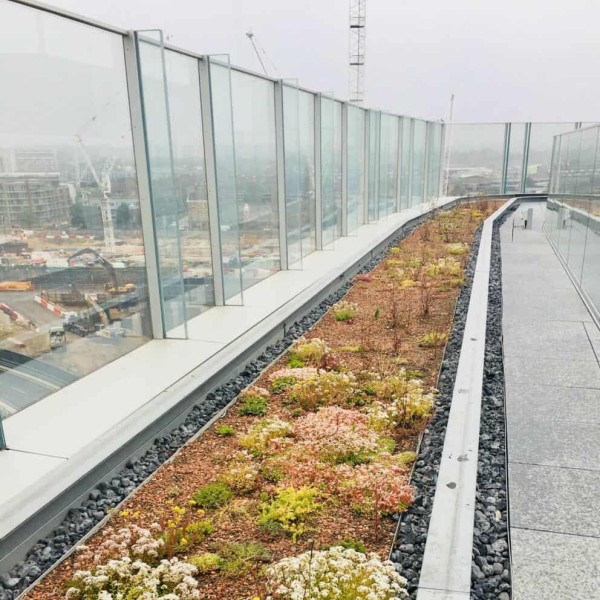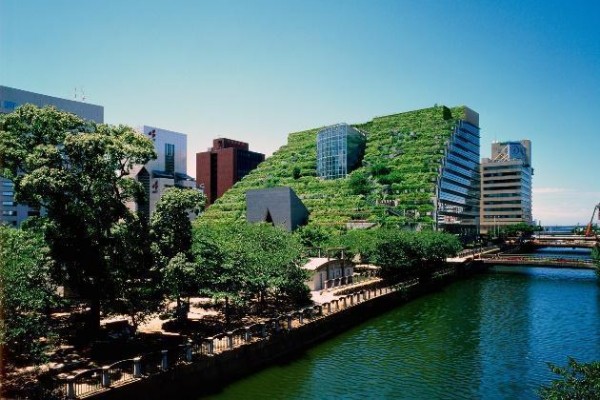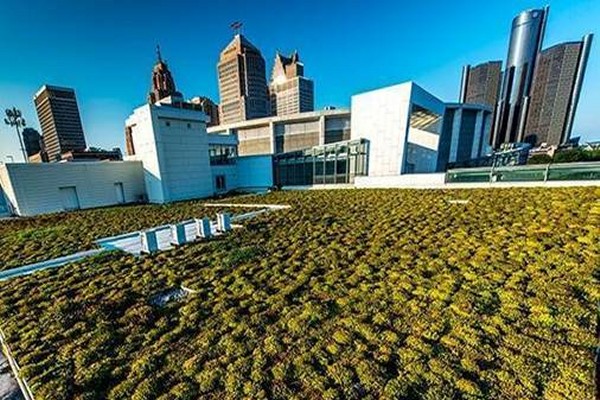Bringing Old Buildings Back to Life
Have you ever thought about what happens to old buildings? Instead of tearing them down, we can actually fix them up and make them useful again! This is important for our planet because it can help us reach “net-zero emissions”. And it is especially important when we talk about “smart cities.” The International Energy Agency (International Energy Agency) claims that we need to fix up about 20% of all buildings around the world by 2030 to make them “zero-carbon-ready”1International Energy Agency, “Renovation of near 20% of existing building stock to zero-carbon-ready by 2030 is ambitious but necessary – Analysis” International Energy Agency. 2022. https://www.iea.org/reports/renovation-of-near-20-of-existing-building-stock-to-zero-carbon-ready-by-2030-is-ambitious-but-necessary. That’s a big job!
Why is this so important? Well, buildings are responsible for about 40% of all the CO₂ emissions that come from energy use. That’s a lot!. So, fixing up old buildings, or “renovating” them, is a big way we can help. When we renovate, instead of just demolishing old buildings and building new ones, we:
- Save Energy: Avoid all the extra energy that goes into making new materials. This is called “embodied carbon,” which is the carbon dioxide emitted during the manufacturing, transportation, and construction of building materials.
- Reduce Waste: Keep things out of landfills by reusing materials.
- Protect History: Keep the special look and feel of old places, which is called “architectural and cultural heritage.”
- Use Smart Tech: Add advanced technology like energy monitors, smart lights, and better heating to make old buildings work better2International Energy Agency, 2022.
This isn’t just about being nice to old buildings. It’s also about big global goals! We’re talking about things like the Paris Agreement, where countries promised to work together to fight climate change, and the United Nations 2030 Agenda for Sustainable Development, which strives to make the world a better place for everyone.
By fixing up old buildings, cities can help achieve SDG 11, which is all about making cities safe, inclusive, and resilient, meaning they can bounce back from challenges. And by making buildings zero-carbon-ready, we’re also working on SDG 13, which is about taking action to stop climate change.
In smart cities, where tech meets green living, fixing up old buildings isn’t just a nice idea, it’s a powerful way to protect our past and build a future that’s good for the planet!
How much do buildings/housing contribute to CO2 emissions?
Okay, so let’s get into the details about why fixing up old buildings is a HUGE deal for our planet. According to the International Energy Agency (IEA)’s Breakthrough Agenda Report 2023, buildings are some of the biggest polluters on Earth.
Here’s the breakdown3International Energy Agency, “The Breakthrough Agenda Report 2023”. International Energy Agency, September 2023. https://iea.blob.core.windows.net/assets/d7e6b848-6e96-4c27-846e-07bd3aef5654/THEBREAKTHROUGHAGENDAREPORT2023.pdf:
- Buildings = Big Pollution: The building sector is one of the largest sources of greenhouse gas (GHG) emissions worldwide.
- Lots of CO₂: About 40% of all the energy-related CO₂ emissions globally come from buildings! That’s a massive chunk.
- Where Does It Come From?: This pollution comes from two main things:
- Operational Energy: All the energy we use in buildings for heating, cooling, lighting, and running appliances.
- Embodied Emissions: The pollution created when we make building materials like cement and steel, and during the construction process.
- Not on Track: Even though we have technologies like heat pumps and energy-efficient appliances, we’re still not doing enough to meet the global “net-zero” goals (where we try to balance the amount of greenhouse gases we put into the atmosphere).
- Emissions Going Back Up: After a small drop during the COVID-19 pandemic, emissions from buildings have gone back up because we’re using more energy in homes and businesses.
The Future Challenge: Double the Buildings!
Here’s another big issue: As more and more people move to cities (rapid urbanisation), especially in countries that are still developing, the world’s building stock is expected to double in size by 20604International Energy Agency, 2023! That’s a LOT of new buildings.
Why is this a problem? If we keep building things the way we are now, the pollution from buildings will get MUCH worse. We need to act NOW.
What Can We Do?
To reach those “net-zero” goals and save our planet, we need to focus on three big things5International Energy Agency, 2023:
- Speed Up Renovations: We need to renovate existing buildings faster. That means fixing them up, making them more energy-efficient, and adding smart tech.
- Better Building Rules: We need to improve building energy codes and standards. These are rules that say how buildings should be designed and built to use less energy.
- Zero-Carbon Buildings: We need to massively increase the number of “zero-carbon-ready” buildings. These are buildings that are designed from the start to produce little or no greenhouse gas emissions.
Basically, if we want to tackle climate change, we HAVE to make all our buildings greener.
Let’s talk renovation and revitalisation
What’s Renovation?
Renovating existing buildings means giving them a makeover and upgrade! We’re talking about improving how they work, how long they last, and making them use less energy. This isn’t just slapping on new paint. It’s adding things like better insulation, new windows, modernising heating and cooling, and installing cool new tech. And we do all of this without knocking the building down and starting over!
This is super important for historical buildings. These buildings are special! They have stories, cool designs, and they’re part of what makes our cities unique. They’re like a timeline of our city’s history. By renovating them, we keep these stories alive and make sure they’re still useful for today. We’re saving our “architectural and cultural heritage” and turning them into “cornerstones of climate-smart urban development“, meaning they become important pieces in making our cities greener and more sustainable!
Watch the video to learn more about renovation projects:
What’s Revitalisation?
Revitalisation is like giving an old building a totally new purpose. It’s about changing how a building is used, so it’s not just sitting there empty or being torn down. Maybe an old factory becomes apartments, or an old train station turns into a community centre. This is great for the environment because it means we’re not wasting materials or energy building something new.
In the EU, the construction industry is responsible for 36% of all emissions! So, if we can use buildings that already exist, we cut down on that pollution. Plus, with more people needing places to live and housing prices going up, revitalising old buildings makes a lot of sense!
Sometimes it might take a lot of work to change a building for a new use. It might take time and be tricky if there are lots of repairs needed. But other times, it can be pretty easy and quick to change a building. It all depends on what we want to do with it!
Basically, both renovation and revitalisation are smart ways to make sure old buildings have a future, help our planet, and create awesome, livable cities!
Look at this video that demonstrates how Ricardo Bofill, a renowned Spanish architect, converted an abandoned cement factory into his studio:
If this type of architecture interests you explore some of Lopes’ other stories: https://www.youtube.com/@lopedetoledo or you can take a look at the short film about Ricardo Bofill available on Netflix.
Fixing Up Old Buildings: Cool or Complicated?
Advantages
Fixing up old buildings has a lot of upsides. It keeps the history and unique style of a city alive while turning unused spaces into something useful, like homes, offices, or community centres. Renovation is usually cheaper and faster than tearing everything down and starting fresh, and it’s also way better for the environment because it reuses materials, cuts down waste, and reduces pollution. These projects can boost the local economy by creating jobs and attracting tourists who want to see cool, historic places. Plus, adding smart technology like energy-efficient heating or digital systems can make cities more sustainable and resilient for the future.
Challenges
At the same time, renovating old buildings can be pretty tricky. Many of them have hidden problems like weak structures, unsafe wiring, or even toxic materials that are expensive to repair. Fitting modern tech and safety systems into older designs without ruining their historic look is also a big challenge. On top of that, strict building codes and heritage protection rules can slow things down or add extra costs. Finally, cities have to balance affordability, sustainability, and community needs, making sure that revitalisation doesn’t just lead to gentrification or push out local residents. In short, it’s a careful balancing act between protecting the past and preparing for the future6Milja Penića, Golovina Svetlana, and Vera Murgul. “Revitalization of Historic Buildings as an Approach to Preserve Cultural and Historical Heritage” Procedia Engineering. 2015. Doi: 117. 888-895.10.1016/j.proeng.2015.08.165. https://www.researchgate.net/publication/282479262_Revitalization_of_Historic_Buildings_as_an_Approach_to_Preserve_Cultural_and_Historical_Heritage.
Real-world examples
Let’s look at some real places where old buildings got amazing makeovers and new purposes! These show how we can make cities cooler, greener, and more sustainable.
- Battersea Power Station, United Kingdom: Imagine a huge, old power plant in London that stopped working in 1983 and just sat there until 2012. That’s what Battersea Power Station was! But now it has been fixed it up and turned it into a place with apartments, shops, and offices. They even made sure to help wildlife! During its revitalisation, 1,000m2 of brown roofs were created for Black Redstarts, and a new Peregrine Falcon nesting site was made in a wash tower. The building also has 2,700m2 of private roof gardens. It shows how we can turn old, abandoned places into cool, useful spaces and help nature at the same time. Now this building is home to high-quality residential, retail and office spaces as well as two protected bird species 7Battersea Power Station. “The History.” No date. https://batterseapowerstation.co.uk/about/heritage-history/ 8Battersea Power Station, “Battersea Power Station – Sustainability and Environment.” No date. https://batterseapowerstation.co.uk/about/sustainability-and-environment/ 9Natalie Hewitt, “The Rising Popularity of Adaptive Reuse Projects in the UK.” 30 May 2024. https://hcarchitects.co.uk/adaptive-reuse/.
 FIG. 1: Brown Roof on top of the Battersea Power Station 15
FIG. 1: Brown Roof on top of the Battersea Power Station 15 FIG. 2: The new roof gardens at the Battersea Power Station10Jonathan Prynn, “Dramatic new roof garden opens at Battersea Power Station.” 9 August 2023. https://www.standard.co.uk/business/dramatic-new-roof-garden-opens-at-battersea-power-station-b1099610.html
FIG. 2: The new roof gardens at the Battersea Power Station10Jonathan Prynn, “Dramatic new roof garden opens at Battersea Power Station.” 9 August 2023. https://www.standard.co.uk/business/dramatic-new-roof-garden-opens-at-battersea-power-station-b1099610.html - Acros Fukuoka, Japan: Built after World War II, the ACROS Fukuoka building was abandoned until architect Emilio Ambasz revitalised it in 1995. Now, it has a symphony hall, a conference center, offices, and shops. But the coolest part is the “Green Waterfall” – a massive green roof garden that goes all the way up the building! It’s like a huge, green mountain! This green roof helps cool down the city by a whole 15°C (about 27°F) and makes the environment better for all sorts of plants and animals 11Vladimir Belogolovsky, “ACROS Fukuoka Prefectural International Hall by Emilio Ambasz turns 25.” 1 September 2020. https://www.stirworld.com/think-columns-acros-fukuoka-prefectural-international-hall-by-emilio-ambasz-turns-25 12Linda Velazquez, “GPW: ACROS Fukuoka Prefectural International Hall.” Green Roofs. 12 August 2011. https://www.greenroofs.com/2011/08/12/gpw-acros-fukuoka-prefectural-international-hall/ 13
Green Roofs. “ACROS Fukuoka Prefectural International Hall.” 10 February 2024. https://www.greenroofs.com/projects/acros-fukuoka-prefectural-international-hall/. FIG. 3: ACROS Fukuoka
FIG. 3: ACROS Fukuoka FIG. 4: ACROS Fukuoka view from the sky
FIG. 4: ACROS Fukuoka view from the sky - The Huntington Place, United States of America: The Huntington Place, formerly known as the Cobo Centre, is an important US conference venue. In 2015, it was revitalised with a $279 million eco-friendly renovation. They added a big green roof, used materials that are good for the environment, and made sure to recycle a lot. They even reuse water and use energy-saving tech. Now, it uses WAY less energy – more than 60% less! The Huntington Place is now a great example of how old buildings can be updated to be green and modern, helping cities become stronger and better for the planet 14Aaron Mondry, “Curbed Detroit – The greenest buildings in Detroit, mapped”. 22 April 2019. https://detroit.curbed.com/maps/greenest-buildings-in-detroit-mapped 15Huntington Place, “Sustainability.” 2022. https://www.huntingtonplacedetroit.com/sustainability 16Mary Klida, “Historic Detroit – Huntington Place.” No date. https://historicdetroit.org/buildings/cobo-center.
 FIG. 5: The Huntington Place front view17Huntington Place, “Huntington Place Convention Center.” No date. https://www.huntingtonplacedetroit.com/
FIG. 5: The Huntington Place front view17Huntington Place, “Huntington Place Convention Center.” No date. https://www.huntingtonplacedetroit.com/ FIG. 6: Green Roof on the Huntington Place18Huntington Place, “Cobo Center grows two more shades of green in 2018.” 28 November 2017. https://www.huntingtonplacedetroit.com/blog/detail/cobo-center-ups-the-sustainability-ante-for-2018
FIG. 6: Green Roof on the Huntington Place18Huntington Place, “Cobo Center grows two more shades of green in 2018.” 28 November 2017. https://www.huntingtonplacedetroit.com/blog/detail/cobo-center-ups-the-sustainability-ante-for-2018 - La Fábrica, Spain: La Fábrica was once an abandoned factory in San Justo Desvern, and now it is the head office of Taller de Arquitectura and the home of Ricardo Bofill – the architect who designed it. The factory was originally built in 1973 and has since been renovated. He kept a lot of the old factory parts but filled the place with plants and gardens. Now, it’s like a green oasis in the middle of a city! It’s a great example of turning an old, industrial place into something beautiful and alive 19Bofill taller de arquitectura. “La Fàbrica”. 2025. https://ricardobofill.com/la-fabrica/read/ 20Danny Hudson, “La Fabrica – Ricardo Bofill’s Time Capsule Factory Renovation”. February 26, 2017. Design Boom. https://www.designboom.com/architecture/ricardo-bofill-la-fabrica-barcelona-spain-02-25-2017/.
 FIG. 7: The Factory before its revitalisation
FIG. 7: The Factory before its revitalisation FIG. 8: The Factory after its revitalisation
FIG. 8: The Factory after its revitalisation
Learn More
- ACROS Fukuoka: https://youtu.be/VuQGhgStHkA
- How To Honour History with Adaptive Reuse: https://www.youtube.com/watch?v=8qdjQBRAoE8
- Buildings that Regenerate | Colin Rohlfing | TEDxStLouis: https://www.youtube.com/watch?v=NErS2mlaxHI
Bibliography
- Almeida, Manuela, Fabrizio Ascione, Anna Laccheo, Teresa Iovane, and Margherita Mastellone, “Towards the Necessary Decarbonization of Historic Buildings: A Review.” 22 January 2025. https://www.mdpi.com/1996-1073/18/3/502
- Andreucci, Maria Beatrice and Selin Karagözler. “Adaptive Reuse of Existing Buildings.” In: Bragança, L., et al., “Circular Economy Design and Management in the Built Environment.” Springer Tracts in Civil Engineering. Springer, Cham. https://doi.org/10.1007/978-3-031-73490-8_11
- Arthur J. Gallagher & Co., “Buildings of Future Past: Adaptive Reuse in Construction.” No date. https://www.ajg.com/news-and-insights/buildings-of-future-past-adaptive-reuse-in-construction/
- Battersea Power Station, “Battersea Power Station – Sustainability and Environment.” No date. https://batterseapowerstation.co.uk/about/sustainability-and-environment/
- Battersea Power Station. “The History.” No date. https://batterseapowerstation.co.uk/about/heritage-history/
- Belogolovsky, Vladimir, “ACROS Fukuoka Prefectural International Hall by Emilio Ambasz turns 25.” 1 September 2020. https://www.stirworld.com/think-columns-acros-fukuoka-prefectural-international-hall-by-emilio-ambasz-turns-25
- Bofill taller de arquitectura. “La Fàbrica”. 2025. https://ricardobofill.com/la-fabrica/read/
- Green Roofs. “ACROS Fukuoka Prefectural International Hall.” 10 February 2024. https://www.greenroofs.com/projects/acros-fukuoka-prefectural-international-hall/
- Hewitt, Natalie, “The Rising Popularity of Adaptive Reuse Projects in the UK.” 30 May 2024. https://hcarchitects.co.uk/adaptive-reuse/
- Hu, Ming and Jakub Świerzawski. “Assessing the environmental benefits of adaptive reuse in historical buildings. A case study of a life cycle assessment approach.” Taylor & Francis Online. 28 July 2024. https://www.tandfonline.com/doi/full/10.1080/27658511.2024.2375439
- Hudson, Danny, “La Fabrica – Ricardo Bofill’s Time Capsule Factory Renovation”. February 26, 2017. Design Boom. https://www.designboom.com/architecture/ricardo-bofill-la-fabrica-barcelona-spain-02-25-2017/
- Huntington Place, “Cobo Center grows two more shades of green in 2018.” 28 November 2017. https://www.huntingtonplacedetroit.com/blog/detail/cobo-center-ups-the-sustainability-ante-for-2018
- Huntington Place, “Huntington Place Convention Center.” No date. https://www.huntingtonplacedetroit.com/
- Huntington Place, “Sustainability.” 2022. https://www.huntingtonplacedetroit.com/sustainability
- International Energy Agency, “Renovation of near 20% of existing building stock to zero-carbon-ready by 2030 is ambitious but necessary – Analysis” International Energy Agency. 2022. https://www.iea.org/reports/renovation-of-near-20-of-existing-building-stock-to-zero-carbon-ready-by-2030-is-ambitious-but-necessary
- International Energy Agency, “The Breakthrough Agenda Report 2023”. International Energy Agency, September 2023. https://iea.blob.core.windows.net/assets/d7e6b848-6e96-4c27-846e-07bd3aef5654/THEBREAKTHROUGHAGENDAREPORT2023.pdf
- Klida, Mary, “Historic Detroit – Huntington Place.” No date. https://historicdetroit.org/buildings/cobo-center
- Maduta, Carmen, D. D’Agostino, Sofia Tsemekidi Tzeiranaki, Luca Castellazzi, Giulia Melica, and Paolo Bertoldi, “Towards climate neutrality within the European Union: Assessment of the Energy Performance of Buildings Directive implementation in Member States.” Energy and Buildings. 2023. 301. 113716. 10.1016/j.enbuild.2023.113716. https://www.researchgate.net/publication/375256813_Towards_climate_neutrality_within_the_European_Union_assessment_of_the_Energy_Performance_of_Buildings_Directive_implementation_in_Member_States
- Mondry, Aaron, “Curbed Detroit – The greenest buildings in Detroit, mapped”. 22 April 2019. https://detroit.curbed.com/maps/greenest-buildings-in-detroit-mapped
- Ossio, Felipe, Carlos Salinas, and Héctor Hernández, “Circular economy in the built environment: A systematic literature review and definition of the circular construction concept.” No date. https://www.sciencedirect.com/science/article/abs/pii/S0959652623018966
- Owojori, Oluwatobi Mary, Chioma Sylvia Okoro, and Nicholas Chileshe. “Current Status and Emerging Trends on the Adaptive Reuse of Buildings: A Bibliometric Analysis” Sustainability 13, no. 21: 11646. 2021. https://doi.org/10.3390/su132111646
- Penića, Milja, Golovina Svetlana, and Vera Murgul. “Revitalization of Historic Buildings as an Approach to Preserve Cultural and Historical Heritage” Procedia Engineering. 2015. Doi: 117. 888-895.10.1016/j.proeng.2015.08.165. https://www.researchgate.net/publication/282479262_Revitalization_of_Historic_Buildings_as_an_Approach_to_Preserve_Cultural_and_Historical_Heritage
- Prynn, Jonathan, “Dramatic new roof garden opens at Battersea Power Station.” 9 August 2023. https://www.standard.co.uk/business/dramatic-new-roof-garden-opens-at-battersea-power-station-b1099610.html
- Steinbrink, Laura, “Revitalizing Aging Buildings: Top Energy Efficiency Upgrades.” 9 January 2025. https://blog.emeraldbe.com/new_blog/revitalizing-aging-buildings-top-energy-efficiency-upgrades
- Storz, Emily, “Open Those Windows: Natural Ventilation in Historic Buildings Can Reduce Mechanical System Use, Save Energy and Create Healthier Indoor Environments.” 5 December 2024. https://drexel.edu/news/archive/2024/December/natural-ventilation-in-historic-buildings-can-reduce-energy-use
- Troi, Alexander, “Historic buildings and city centres – the potential impact of conservation compatible energy refurbishment on climate protection and living conditions”. April 8th, 2011. Energy Management in Cultural Heritage, 6. https://build-up.ec.europa.eu/sites/default/files/content/2011_EM_Troi_Impact.pdf?utm
- The American Institute of Architects, “Building Reuse: A Proven Climate and Economic Strategy.” No date. https://www.aia.org/sites/default/files/2024-10/AIA_NTHP_Building_Reuse.pdf
- United States Environmental Protection Agency, “Sustainable Management of Construction and Demolition Materials.” 16 January 2025. https://www.epa.gov/smm/sustainable-management-construction-and-demolition-materials
- Velazquez, Linda, “GPW: ACROS Fukuoka Prefectural International Hall.” Green Roofs. 12 August 2011. https://www.greenroofs.com/2011/08/12/gpw-acros-fukuoka-prefectural-international-hall/
- World Meteorological Organization. “World Meteorological Organization – Urban heat island.” No date. https://community.wmo.int/en/activity-areas/urban/urban-heat-island
These articles have been reviewed using AI in order to align the style and length of each article. The research and content are original to the authors noted.

